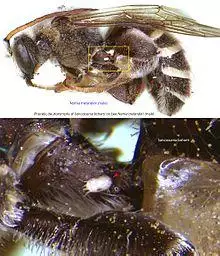| Alkali bee | |
|---|---|
 | |
| Male bee. The lower frame is a blow-up of the small rectangle in the upper frame, showing a Zodion obliquefasciatum parasitizing him. | |
| Scientific classification | |
| Kingdom: | Animalia |
| Phylum: | Arthropoda |
| Class: | Insecta |
| Order: | Hymenoptera |
| Family: | Halictidae |
| Genus: | Nomia |
| Subgenus: | Nomia (Acunomia) |
| Species: | N. melanderi |
| Binomial name | |
| Nomia melanderi (Cockerell, 1906) | |
The alkali bee, Nomia melanderi,[1] is a ground-nesting bee native to deserts and semi-arid desert basins of the western United States. It was described by Theodore Dru Alison Cockerell in 1906.
This bee nests in salt-saturated, or alkaline, soil. Like some other bees such as Megachile rotundata, alkali bees are an effective pollinator of alfalfa.[2] The bee uses a specialized technique of opening alfalfa flowers for pollination by applying pressure to snap open the keel of the flower. Due to the unusual nesting habits of this bee, farmers have developed methods to accommodate them with salty mud-fields where they can burrow and lay their eggs. Farmers started doing this after realizing that plowing up natural flats like these decreased the yield of alfalfa dramatically.[3][4]
It is preyed upon by the conopid fly Zodion obliquefasciatum.[5]
Juvenile hormone (JH) analog methoprene can serve as a possible limiting factor for alkali bees since female bees are more likely to reach reproductive maturity with JH.[6] Alkali bees are also considered solitary bees because females have their individual nests and live alongside other female alkali bees.
References
- ^ "Nomia melanderi Cockerell, 1906". Integrated Taxonomic Information System.
- ^ "...Nomia melanderi, sustainably managed to pollinate alfalfa ...", USDA
- ^ Moisset, Beatriz; Wojcik, Vicki. "The Alkali Bee (Nomia melanderi)". USDA Forest Service.
- ^ Matthew Cobb (Aug 11, 2018). "Buzz: A beautiful book shows why modern bees are hippy wasps at heart". New Scientist. (A book review of Buzz by Thor Hanson.)
- ^ Howell, J.F. (1967). "Biology of Zodion obliquefasciatum (Macq.) (Diptera: Conopidae) a parasite of the alkali bee, Nomia melanderi Ckll. (Hymenoptera: Halictidae)". Bulletin of the Washington Agriculture Experimental Station. 51: 1–33.
- ^ Kapheim, Karen M.; Johnson, Makenna M. "Juvenile hormone, but not nutrition or social cues, affects reproductive maturation in solitary alkali bees (Nomia melanderi)". Journal of Experimental Biology. 220. doi:10.1242/jeb.162255.